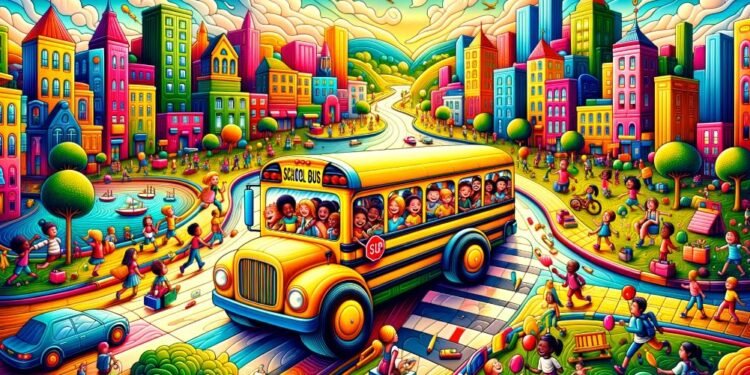Last Updated on November 13, 2023 by admin
Introduction
The melody of “The Wheels on the Bus” has transcended generations, becoming a cornerstone in childhood education and entertainment. Originating as a simple nursery rhyme, this song has evolved into a cultural phenomenon, illustrating the motions of a bus and the essence of early learning and community life. In this article, we delve into the origins, cultural impact, educational significance, and contemporary adaptations of “The Wheels on the Bus,” exploring how a simple tune has become an integral part of childhood.
Origins and Historical Background
The journey of “The Wheels on the Bus” began in the mid-20th century, though its origins remain somewhat obscure. Often attributed to American folk singer Verna Hills, who popularized it in the 1930s, the song quickly gained traction in the United States and subsequently worldwide. Its repetitive, easy-to-learn lyrics and melody made it a hit among children and educators alike. The song’s simplicity hides its historical context, mirroring the burgeoning urbanization and the increased prominence of buses as a mode of public transportation in the post-war era.
Cultural Significance and Adaptations
Over the years, “The Wheels on the Bus” has transcended its initial purpose as a children’s song, becoming a cultural icon. It has been adapted into various languages and cultural contexts, showcasing its universal appeal. Each version reflects the local culture, making it a unique tool for cultural exchange among children across the globe. The song has also made its way into popular media, featured in movies, TV shows, and commercials, further cementing its place in popular culture.
Educational Impact and Learning Benefits
From an educational standpoint, “The Wheels on the Bus” is more than just a song; it’s a learning tool. Its repetitive structure and simple lyrics make it ideal for language development, memory, and motor skills. Children learn about rhythm, rhyme, and melody, which are crucial elements in early literacy and language acquisition. Additionally, the song introduces young learners to various sounds and actions, fostering their auditory and kinesthetic learning abilities. The inclusion of activities like the swishing of wipers or the opening and closing of doors encourages physical movement, enhancing motor skill development in young children.
Psychological Perspectives
Psychologically, “The Wheels on the Bus” provides children with a sense of comfort and familiarity. The predictability of the song offers a safe learning environment where children can experiment with sounds and words without fear of making mistakes. Furthermore, the song’s themes of travel and movement can stimulate children’s imagination and curiosity about the world around them. It also serves as a social tool, helping children understand and mimic the everyday activities they observe, such as people interacting on a bus.
The Song in Modern Education
“The Wheels on the Bus” remains a staple in modern educational settings. It’s often used in preschools and kindergartens as part of music and movement activities. Educators have adapted the song to create interactive learning experiences, incorporating it into lessons about transportation, community helpers, and even basic mechanics of how buses work. Its adaptability also allows for introducing new verses to teach different concepts, making it an ever-evolving educational resource.
Technological Integration and Digital Adaptations
With the advent of digital media, “The Wheels on the Bus” has found new life through animated videos, interactive apps, and online games. These digital adaptations have made the song more accessible and engaging for the tech-savvy younger generation. The interactive elements of these platforms provide an enhanced sensory experience, catering to diverse learning styles and needs. Digital versions often include creative visualizations and scenarios, further enriching the storytelling aspect of the song.
Societal Impact and Community Building
“The Wheels on the Bus” also significantly affects community building and societal impact. It’s a song that brings together children from various backgrounds, promoting inclusivity and social interaction. Group singing of the song in classrooms or playgrounds fosters a sense of community and shared experience among children. It also provides an avenue for parents and educators to engage with children fun and meaningfully, strengthening bonds and facilitating communal learning.
The Song’s Legacy and Future
As we look towards the future, the legacy of “The Wheels on the Bus” remains secure. Its ability to adapt and stay relevant in changing times is a testament to its enduring appeal. As educational trends evolve and new technologies emerge, the song will likely undergo further adaptations, continuing to resonate with new generations of children. Its simplicity, educational value, and universal appeal ensure that “The Wheels on the Bus” will continue to be a beloved melody, echoing through the halls of childhood memory for years to come.
Conclusion
In conclusion, “The Wheels on the Bus” is more than a nursery rhyme; it symbolizes childhood, a tool for education, and a melody that connects generations. From its humble beginnings to its present-day status as a cultural and educational staple, the song has journeyed through time, bringing joy, learning, and a sense of community to children worldwide. As we continue to explore and adapt this classic tune, it remains a cherished part of our collective childhood experience, rolling along through the annals of time.
Also, Read Ben 10-Alien Heroics Across Time.









